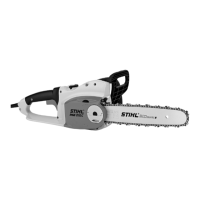MSE 170 C, MSE 190 C, MSE 210 C, MSE 230 C
English
14
2. Swing the machine slowly into the
plunge cutting position – risk of
kickback and pushback!
3. Make the plunge cut very carefully –
danger of pushback!
Where possible, use a plunge blade.
The plunge blade and the upper/lower
side of the guide bar are parallel.
During plunge cutting, the plunge bar
helps to keep the hinge parallel in form,
i.e. the same thickness at all points. To
do this, guide the plunge bar parallel to
the sink chord.
Felling wedges
Insert the felling wedge as soon as
possible, i.e. as soon as saw control
cannot be hindered. Position the felling
wedge in the backcut and drive in with
suitable tools.
Only use aluminium or plastic wedges –
do not use steel wedges. Steel wedges
can seriously damage the saw chain and
cause dangerous kickback.
Select suitable felling wedges
dependent on the trunk diameter and the
width of the kerf (analogue to backcut
(E)).
Contact the STIHL servicing dealer for
the selection of the felling wedge
(suitable length, width and height).
Select the appropriate backcut
The selection of the appropriate backcut
is dependent on the same tree
characteristics that must be noted when
determining the direction of fall and the
escape paths.
There are various different features of
these characteristics. This Instruction
Manual will only describe the two most
commonly occurring variants:
Back cut with safety strip (normal tree)
(A) Thin trunks
Implement this backcut when the trunk
diameter is smaller than the cutting
length of the machine.
Give a warning cry of "timber!" before
making the backcut.
N Plunge cut the backcut (E) – plunge
the guide bar fully in
N Engage the bumper spike behind
the hinge and use this as the
rotation point – reposition the
machine as little as possible
N Make the backcut up to the
hinge (1)
– Do not cut into the hinge
N Make the backcut up to the safety
strip (2)
– Do not cut into the safety strip

